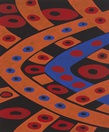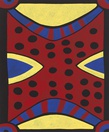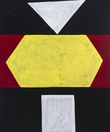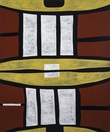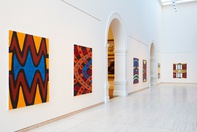Gordon Bennett
Lived and worked Brisbane
2017
Displayed 2017 at Art Gallery of New South Wales

Gordon Bennett
Born 1955, Monto, Queensland. Lived and worked Brisbane. Died 2014, Brisbane
Gordon Bennett’s practice examines historical and contemporary constructions of personal and cultural identity. Internationally acclaimed, he was one of Australia’s most prominent and critically engaged artists. Equipped both intellectually and aesthetically, Bennett is accredited for his powerful perspectives on the postcolonial experience, focusing in particular on the role of language and systems of thought in the development and structuring of identity. He firmly questioned and rejected racial stereotypes, often painting under a pop art-inspired alter ego, John Citizen, in a bold attempt to expand his oeuvre and avoid typecasting his practice.
Artist text
by Wayne Tunnicliffe
The boldly configured abstract paintings in Gordon Bennett’s final series, Home Décor (after M. Preston) (2012–13), are not immediately recognisable as appropriations, compared with his earlier exemplary postmodern works that combine multiple visual sources from high and popular culture. Their deliberate art deco-influenced ‘neo-primitivism’ provides a clue to their origin in designs by Margaret Preston from the 1920s and early 30s, which she, in turn, derived from Aboriginal sources. (1) Preston published these designs in articles advocating for the development of a national visual language through studying Aboriginal art for its uniquely local and original qualities: ideas she situated within the context of the renewal of western art internationally through the borrowing of non-western art forms. Preston proposed for her initial designs to be used in decorative arts for domestic purposes, and, for example, Bennett’s #18 (2012) is taken from an image published in 1925 as a ‘design from a Golmary shield, North Queensland, which … may be applied to mats, cushions or splash mats’. (2)
In this context Bennett’s choice of series title, Home Décor (after M. Preston), suggests the comfortably if unintentionally racist home interiors that Preston seems to promote and in which Aboriginal culture provides a distinctive decorative backdrop for non-Aboriginal Australians to feel at home within Australia. Bennett’s reappropriations greatly enlarge Preston’s modestly scaled works, however, giving them the presence of ambitious formalist paintings. He utilises the same colours advocated by Preston as ‘Aboriginal’, but Bennett’s versions show painterly brushstrokes that mark his physical presence as an artist, as he turns her ‘décor’ into fine art. (3) Bennett brings back into circulation displaced echoes of the work of the unknown makers that were the original source for his and Preston’s work. He points to the troubled history of modernism’s search for an authentic national ‘self’ and shows how something as simple as home décor can resonate with nation-building ideologies and enterprises, as well as with unresolved issues and tensions around race relations and national identity in Australia today.
In The National 2017: New Australian Art Bennett’s work hangs in the Central Court of the Art Gallery of New South Wales (AGNSW), located between the grand neoclassical Old Courts of 19th-century art and the modernist rooms that display 20th-century Australian art. While Aboriginal people as subjects appear in the earliest paintings by colonial artists and the influence of Aboriginal art is apparent from the 1920s onwards, Aboriginal art itself only began to be collected by the AGNSW from the late 1940s and was only recently integrated into these collection displays in the final rooms of the 20th-century galleries. (4) Exhibited in this context, Bennett’s Home Décor (after M. Preston) paintings emphasise some of the gaps and silences in institutional cultural narratives through reconsidering specific histories, suggesting alternate viewpoints to modernist ideas of cultural and societal progression, and highlighting how formalist visual languages are anything but self-referential and apolitical.
Notes
(1) In the mid-1920s, Preston’s vision was initially more regionally syncretic with designs based on New Guinea and Fijian art as well as Aboriginal sources. For a thorough analysis of Preston’s engagement with Aboriginal art, see Deborah Edwards, Margaret Preston, Art Gallery of New South Wales, Sydney, 2005, various chapters.
(2) Margaret Preston, ‘The Indigenous art of Australia’, Art in Australia, ser.3, no.11, March 1925, unpaginated.
(3) Preston did incorporate Aboriginal elements into her art practice in the 1920s, but particularly from the early 1940s she attempted to develop a hybrid European-Aboriginal-Australian art with highly variable and often problematic results.
(4) An exception was the group of Tutini (Pukumani grave posts) from Melville Island, commissioned by the AGNSW in 1959 and initially displayed in the 19th-century galleries with a group of barks from Groote Eylandt before finding a home in the new ‘Primitive Art’ gallery located underneath the 19th-century galleries from 1973 to 1994.

